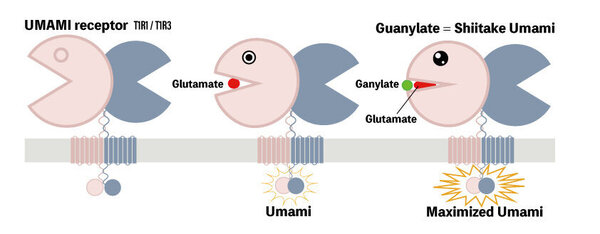- HOME
- Umami
- Natural Umami booster
How does Shiitake enhance Umami?
When Glutamate enters the Umami receptors on the tongue, we feel the Umami taste. Guanylate has the effect of closing the opening of the Umami receptors so that we can feel the Umami taste intensity longer and stronger. The Umami effect provides for a more balanced taste and better overall flavor of foods (which also contributes to using less salt to make foods taste good).
Glutamate is abundant in various foods, but Guanylate is only found in a few foods, such as dried Shiitake mushrooms.
Verifying our statements: Academic Papers on Umami.
"Humans recognize the umami taste as an indicator of accessible protein in food, and the taste sensation is triggered by free amino acids, in particular by binding of the l-glutamate ion to umami taste receptors in the tongue. Glutamate (Glu) is the most abundant amino acid in human breast milk, suggesting that the newborn child is primed early for umami sensing." Read the paper
"In humans, a large synergism occurs between MSG and IMP or GMP. The maximal taste intensities of mixtures of MSG and IMP or MSG and GMP were 7 and 30 times." Read the paper
"An even more dramatic synergistic effect has been shown for MSG-GMP combinations, where a 30-fold increase in flavor intensity has been reported when equal amounts of MSG and GMP were utilized.
These data would indicate that at their optimum effectiveness MSG-GMP combinations are approximately four times more synergistically potent than MSG-IMP." Read the paper
"Combinations of soy sauce with either mycoprotein derivative, shiitake extract, or concentrated tomato extract led to maximized umami taste in the meat." Read the paper
Dried Shiitake's 3rd Umami provides the synergy for the most delicious Umami (1. Glutamate, 2. Inosinate, 3. Guanylate) <= Learn More
Natural Umami Booster: Forest-grown Shiitake Powder <= Learn More


